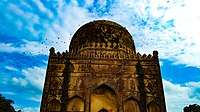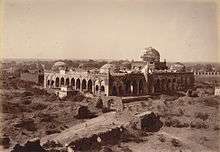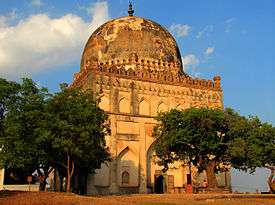Bahmani Sultanate
| Bahmani Sultanate | |||||||||||||||||||||
|---|---|---|---|---|---|---|---|---|---|---|---|---|---|---|---|---|---|---|---|---|---|
| 1347–1527 | |||||||||||||||||||||
 Bahmani Sultanate, 1470 CE | |||||||||||||||||||||
| Capital | |||||||||||||||||||||
| Common languages | |||||||||||||||||||||
| Religion | Shia Islam[1][2] | ||||||||||||||||||||
| Government | Monarchy | ||||||||||||||||||||
| Sultan | |||||||||||||||||||||
• 1347–1358 | Ala-ud-Din Bahman Shah | ||||||||||||||||||||
• 1525–1527 | Kalim-Allah Shah | ||||||||||||||||||||
| Historical era | Late Medieval | ||||||||||||||||||||
• Established | 3 August 1347 | ||||||||||||||||||||
• Disestablished | 1527 | ||||||||||||||||||||
| |||||||||||||||||||||
| Today part of |
| ||||||||||||||||||||
| Part of a series on the |
| History of Karnataka |
|---|
|
| Categories |
|
The Bahmani Sultanate (also called the Bahmanid Empire or Bahmani Kingdom) was a Muslim state of the Deccan in South India and one of the major medieval Indian kingdoms.[3] Bahmanid Sultanate was the first independent Muslim kingdom in South India.[4] The Kingdom later split into five offshoots that were collectively known as the Deccan sultanates.The last remnant of the Bahmani sultanate was defeated and destroyed in 1509 by Vijayanagar Empire.
History
The empire was established by a Ismaili military general from Badakhshan (Afghanistan), Ala-ud-Din Bahman Shah, after revolting against the turkic Delhi Sultanate of Muhammad bin Tughlaq.[5] Nazir Uddin Ismail Shah who had revolted against the Delhi Sultanate stepped down on that day in favour of Bahman Shah. His revolt was successful, and he established an independent state on the Deccan within the Delhi Sultanate's southern provinces. The Bahmani capital was Hasanabad (Gulbarga) between 1347 and in 1425 it was moved to Muhammadabad (Bidar). The Bahmani contested the control of the Deccan with the Vijayanagara Empire to the south. The sultanate reached the peak of its power during the vizierate (1466–1481) of Mahmud Gawan. The south Indian Emperor Krishnadevaraya of the Vijayanagara Empire defeated the last remnant of Bahmani Sultanate power after which the Bahmani Sultanate collapsed.[6] After 1518 the sultanate broke up into five states: Nizamshahi of Ahmednagar, Qutb Shahi of Golconda (Hyderabad), Baridshahi of Bidar, Imadshahi of Berar, Adilshahi of Bijapur. They are collectively known as the "Deccan Sultanates".
Society and Culture
Rulers of the dynasty believed that they descended from Bahman, the mythological figure of Greater Iranian legend and lore. The Bahamani Sultans were patrons of the Persian language, culture and literature, and some members of the dynasty became well-versed in that language and composed its literature in that language.[4]

The first sultan, Alauddin Bahman Shah is noted to have captured 1,000 singing and dancing girls from Hindu temples after he battled the northern Carnatic chieftains. The later Bahmanis also enslaved civilian women and children in wars; many of them were converted to Islam in captivity.[7][8] The craftspersons of Bidar were so famed for their inlay work on copper and silver that it came to be known as Bidri.
Although the sultanate practice Shi'a Islam, the majority of the population adhered to Hinduism. The common people, who were mostly Hindus, had to adjust their religious practices to become more acceptable to their Muslim political masters.[9]
List of Bahmani Shahs
| Titular Name | Personal Name | Reign | |
|---|---|---|---|
| Independence from Sultan of Delhi, Muhammad Tughlaq. | |||
| Shah شاہ Ala-ud-Din Bahman Shah علاء الدین حسن بہمن شاہ |
Ala-ad-Din Bahman Shah I حسن گنگو |
3 August 1347 – 11 February 1358 | |
| Shah شاہ |
Mohammad Shah I محمد شاہ بہمنی |
11 February 1358 – 21 April 1375 | |
| Shah شاہ Ala-ud-Din Mujahid Shah علاء الدین مجاہد شاہ |
Mujahid Shah | 21 April 1375 – 16 April 1378 | |
| Shah شاہ |
Dawood Shah داود شاہ بہمنی |
16 April 1378 – 22 May 1378 | |
| Shah شاہ |
Mohammad Shah II محمود شاہ بہمنی |
21 May 1378 – 20 April 1397 | |
| Shah شاہ |
Ghiyath-ad-din Shah عیاث الدین شاہ بہمنی |
20 April 1397 – 14 June 1397 | |
| Shah شاہ |
Shams-ad-din Shah شمس الدین شاہ بہمنی Puppet King Under Lachin Khan Turk |
14 June 1397 – 15 November 1397 | |
| Shah شاہ Taj-ud-Din Feroze Shah تاج الدین فیروز شاہ |
Feroze Shah فیروز خان |
24 November 1397 – 1 October 1422 | |
| Shah شاہ |
Ahmed Shah Wali Bahmani احمد شاہ ولی بہمنی |
1 October 1422 – 17 April 1436 | |
| Shah شاہ Ala-ud-Din Ahmed Shah علاء الدین احمد شاہ |
Ala-ud-Din Ahmed Shah Bahmani علاء الدین احمد شاہ بہمنی |
17 April 1436 – 6 May 1458 | |
| Shah شاہ Ala-ud-Din Humayun Shah علاء الدین ھمایوں شاہ |
Humayun Shah Zalim Bahmani ھمایوں شاہ ظالم بہمنی |
7 May 1458 – 4 September 1461 | |
| Shah شاہ |
Nizam Shah Bahmani نظام شاہ بہمنی |
4 September 1461 – 30 July 1463 | |
| Shah شاہ Muhammad Shah Lashkari محمد شاہ لشکری |
Muhammad Shah Bahmani II محمد شاہ بہمنی دوئم |
30 July 1463 – 26 March 1482 | |
| Vira Shah ویرا شاہ |
Mahmood Shah Bahmani II محمود شاہ بہمنی دوئم |
26 March 1482 – 27 December 1518 | |
| Shah شاہ |
Ahmed Shah Bahmani II احمد شاہ بہمنی دوئم Puppet King Under Amir Barid I |
27 December 1518 – 15 December 1520 | |
| Shah شاہ Ala-ud-Din Shah علاء الدین شاہ |
Ala-ud-Din Shah Bahmani II علاء الدین شاہ بہمنی دوئم Puppet King Under Amir Barid I |
28 December 1520 – 5 March 1523 | |
| Shah شاہ |
Waliullah Shah Bahmani ولی اللہ شاہ بہمنی Puppet King Under Amir Barid I |
5 March 1522 – 1526 | |
| Shah شاہ |
Kaleemullah Shah Bahmani کلیم اللہ شاہ بہمنی Puppet King Under Amir Barid I |
1525–1527 | |
| Dissolution of the Sultanate into 5 Kingdoms namely; Bidar Sultanate; Ahmednagar Sultanate; Bijapur Sultanate; Golconda Sultanate and Berar Sultanate. | |||

 Taj ud-Din Firuz Shah of the Bahmani Sultanate's Firman.
Taj ud-Din Firuz Shah of the Bahmani Sultanate's Firman.
 Tomb of Ahmad Shah I Wali.
Tomb of Ahmad Shah I Wali.
See also
Historiography
Modern scholars have based their accounts on Bahmani dynasty mainly upon the medieval chronicles of Firishta, Syed All Tabatabai, etc. Other contemporary works were Sivatatva Chintamani and Guru Charitra. Athanasius Nikitin traveled this kingdom. He contrasts the huge wealth of the nobility with the wretchedness of the peasantry and the frugality of Hindus.
Vincent Smith and Nilakanta Sastri stated that the Bahmani Sultans were fanatics and did not show any interest in general welfare of their subjects.[9]
References
- ↑ Shia Islam in India, Islamic Civilization in South Asia: A History of Muslim Power and Presence in the Indian subcontinent, (Routledge, 2013), 91.
- ↑ Farooqui Salma Ahmed, A Comprehensive History of Medieval India: From Twelfth to the Mid-Eighteenth Century, (Dorling Kindersley Pvt. Ltd., 2011), 170.
- ↑ "The Five Kingdoms of the Bahmani Sultanate". orbat.com. Archived from the original on 23 February 2007. Retrieved 2007-01-05.
- 1 2 Ansari, N.H. "Bahmanid Dynasty" Archived 19 October 2006 at the Wayback Machine. Encyclopaedia Iranica
- ↑ Sen, Sailendra (2013). A Textbook of Medieval Indian History. Primus Books. pp. 106–108, 117. ISBN 978-9-38060-734-4.
- ↑ Eaton, Richard M. A Social History of the Deccan, 1300–1761: Eight Indian Lives. p. 88.
- ↑ Cambridge History of India ed. Wolseley Haig, Vol. III, p391, 397-398
- ↑ Sewell, Robert. A Forgotten Empire (Vijayanagar) pp.57-58.
- 1 2 http://shodhganga.inflibnet.ac.in/bitstream/10603/108004/8/08_chapter%201.pdf
Further reading
- Avari, Burjor (2013), Islamic Civilization in South Asia: A history of Muslim power and presence in the Indian subcontinent, Routledge, ISBN 978-0-415-58061-8
- Kulke, Hermann; Rothermund, Dietmar (2004), A History of India (Fourth ed.), Routledge
External links
| Wikiquote has quotations related to: Bahmani Sultanate |